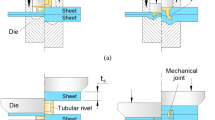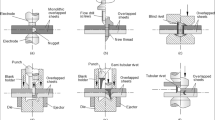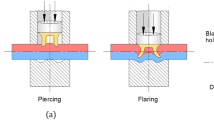Abstract
This paper is focused on solving the problems of positioning and alignment of rivets in double-sided self-pierce riveting by means of flat-bottom holes that are previously machined in the overlapped sheets with greater mechanical strength. The work combines experimentation in joints made from dissimilar materials (aluminium AA5754-H111 and polyvinylchloride) with finite element modelling to investigate the influence of the flat-bottom hole geometry in the overall joining mechanisms. It is shown that the use of flat hole-bottom holes with rivets having identical chamfered angles in both ends is unable to create undercuts and to produce form-closed mechanical interlockings. Undercuts are created if different chamfered angles in the rivet ends are introduced to compensate the greater or lesser difficulty of the rivets to pierce through sheets with different mechanical strengths. Destructive shear and peel tests performed with different types of joints confirm the good performance of the joints produced by double-sided self-pierce riveting with flat-bottom holes.








Similar content being viewed by others
Availability of data and materials
Authors confirm that the data and material supporting the findings of this work are available within the article.
Code availability
Not applicable.
References
Meschut G, Janzen V, Olfermann T (2014) Innovative and highly productive joining technologies for multi-material lightweight car body structures. J Mater Eng Perform 25:1515–1523
Johnson P (2020) Quality control and nondestructive testing of self-piercing riveted joints in aerospace and other applications. In: Chaturvedi M (ed) Welding and joining of aerospace materials. Woodhead Publishing, UK
Groche P, Wohletz S, Brenneis M, Pabst C, Resch F (2014) Joining by forming—a review on joint mechanisms, applications and future trends. J Mater Process Technol 214:1972–1994
Li D, Chrysanthou A, Patel I, Williams G (2017) Self-piercing riveting—a review. Int J Adv Manuf Technol 92:1777–1824
Kato K, Okamoto M, Yasuhara T (2001) Method of joining sheets by using new type of rivets. J Mater Process Technol 111:198–203
Huang Z, Yao Q, Lai J, Zhao J, Jiang Z (2017) Developing a self-piercing riveting with flange pipe rivet joining aluminium sheets. Int J Adv Manuf Technol 91:2315–2328
Huang Z, Xue S, Lai J, Xia L, Zhan J (2014) Self-piercing riveting with inner flange pipe rivet. Proc Eng 81:2042–2047
Alves LM, Afonso RM, Pereira PT, Martins PAF (2021) Double-sided self-pierce riveting of dissimilar materials. Int J Adv Manuf Technol. https://doi.org/10.1007/s00170-021-07426-3
Alves LM, Afonso RM, Martins PAF (2020) Double-sided self-pierce riveting. Int J Adv Manuf Technol 108:1541–1549
Alves LM, Afonso RM, Martins PAF (2021) Double-sided self-pierce riveting of polymer sheets. J Adv Joining Proc 3:100051
Nielsen CV, Zhang W, Alves LM, Bay N, Martins PAF (2013) Coupled finite element flow formulation. In: Davim JP (ed) Modelling of thermo-electro-mechanical manufacturing processes with applications in metal forming and resistance welding. Springer, New York. https://doi.org/10.1007/978-1-4471-4643-8_3
Nielsen CV, Martins PAF. (2021) Finite element simulation: a user’s perspective In: Metal forming: formability, simulation and tool design. Academic Press, London. https://doi.org/10.1016/B978-0-323-85255-5.00011-X
Acknowledgements
The authors would like to thank the support provided by Fundação para a Ciência e a Tecnologia of Portugal and IDMEC under LAETA-UIDB/50022/2020.
Funding
The research was supported by Fundação para a Ciência e a Tecnologia of Portugal and IDMEC under LAETA- UIDB/50022/2020.
Author information
Authors and Affiliations
Contributions
LMA: Conceptualization, Investigation, Methodology, Experimentation, Writing -editing. RMA: Investigation, Experimentation, Visualization, Writing -editing. PTP: Numerical Modelling, Visualization. PAFM: Funding acquisition, Methodology, Numerical Modelling, Supervision, Writing—original draft.
Corresponding author
Ethics declarations
Conflict of interest
The authors have no competing interests or conflicts of interest to declare that are relevant to the contents of this article.
Ethical approval
The article follows the guidelines of the Committee on Publication Ethics (COPE) and involves no studies on human or animal subjects.
Consent to participate
Not applicable.
Consent for publication
Not applicable.
Additional information
Publisher's Note
Springer Nature remains neutral with regard to jurisdictional claims in published maps and institutional affiliations.
Rights and permissions
About this article
Cite this article
Alves, L.M., Afonso, R.M., Pereira, P.T. et al. Double-sided self-pierce riveting with flat-bottom holes: a feasibility study. Prod. Eng. Res. Devel. 16, 401–409 (2022). https://doi.org/10.1007/s11740-021-01082-y
Received:
Accepted:
Published:
Issue Date:
DOI: https://doi.org/10.1007/s11740-021-01082-y




